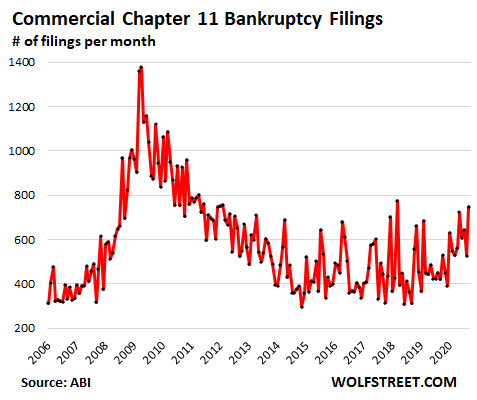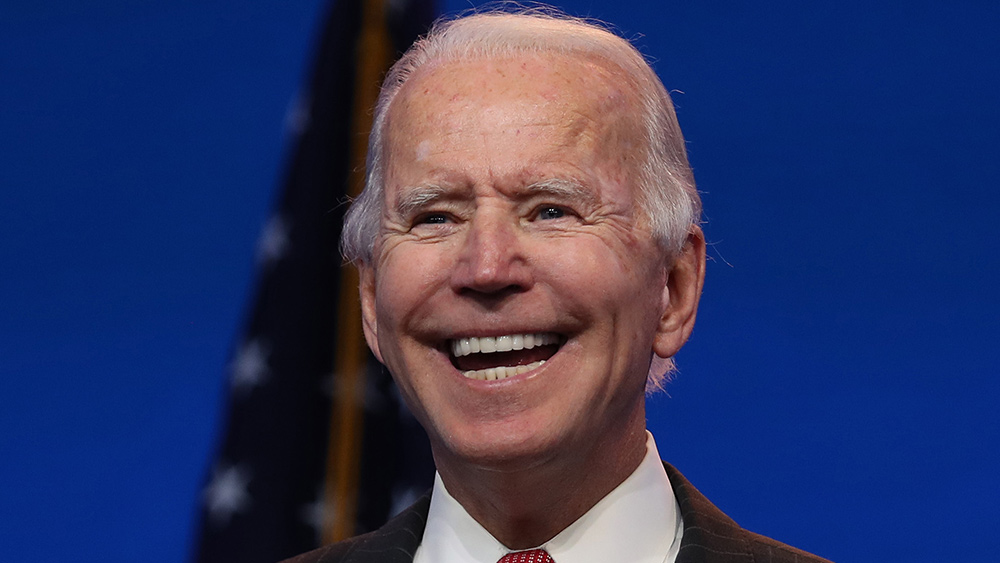Twisted Bailout Economy: Chapter 11 Bankruptcies Surged, But Commercial Chapter 13 Bankruptcies Plunged. 420,000 Small Businesses Closed Quietly, Highest Rate Ever
by Wolf Richter, Wolf Street:
 Stimulus and bailouts had a huge impact, for those that got them, and for those that didn’t.
Stimulus and bailouts had a huge impact, for those that got them, and for those that didn’t.
In the world of struggling businesses, debt defaults, bankruptcies, and closures, there is now a clear dividing line.
On one side are those businesses that got bailed out by the government, whether they needed it or not, such as the $25 billion in grants and loans for a handful of airlines, or the $525 billion in PPP loans handed to 5.2 million business entities, from minuscule to large, and some fraudulent. On the same side are businesses with access to the capital markets that got bailed out by the Fed whose corporate bond buying programs drove credit markets into frenzy, eager to fund nearly anything.
But on the other side, are those businesses who didn’t get any of this – neither from the government, nor from the Fed, nor from the frenzied credit markets; and those businesses, often already limping for a while, got run over by the Pandemic.
In terms of publicly traded companies.
In September, another 54 large companies filed for bankruptcy, after 54 had already filed for bankruptcy in August, according to S&P Global Market Intelligence, bringing the total for the year as of October 4 to 509, the highest for the same period since 2010.
These are companies that are either publicly traded (minimum $2 million in assets or liabilities), or are private companies with debt that is publicly traded (minimum $10 million).
The largest bankruptcy filers in September included two Texas-based oil and gas producers: Oasis Petroleum, with over $3 billion in liabilities; and Lonestar Resources with $626 million in liabilities.
Energy companies were only in third place among the sectors with the most bankruptcy filings year-to-date. Here are the S&P’s top five bankruptcy sectors, with the number of filings so far:
- Consumer discretionary: 103
- Industrials: 70
- Energy: 58
- Healthcare 47
- Consumer staples: 27
The long list of chain-store retailers that have filed for bankruptcy during the Pandemic got longer in September with filings, among others, by off-price department store Century 21 (Sep 10), candy-seller It’Surgar (Sep 23), and Forever 21 (Sep 30).
Many retailers, when they file for bankruptcy, end up getting liquidated.
The Federal Reserve Bank of San Francisco, fretting about over-indebted companies becoming even more over-indebted during the Pandemic, said that the number of companies that have defaulted on their debt this year so far “is on course to be the highest since 2009.”
Commercial Chapter 11 bankruptcy filings surge.
This type of filing occurs when a business attempts to restructure its debts while continuing operations, usually with shareholders losing the company, and with creditors taking it. Chapter 11 filings are seasonal, spiking during tax season in March or April. With the tax-filing deadline moved to July 15 this year, the spring spike stretched out over five months. And you would expect, given seasonal patterns, that filings would then taper off. But that’s not what happened.
In September, commercial Chapter 11 filings jumped by 78% year-over-year to 747 filings, the highest since the seasonal spike in March 2018, and beyond that the highest since 2012, according to data released today by the American Bankruptcy Institute. It was the seventh month of double-digit year-over-year increases. From March through September, commercial Chapter 11 filings jumped 40%, compared to the same period last year. Clearly, these companies didn’t get any bailouts:

Most small businesses, when they file for bankruptcy, do so either under Chapter 7 (for corporations, partnerships, LLCs, and sole proprietorships) or under Chapter 13 (individuals only, such as sole proprietorships).
Commercial Chapter 13 bankruptcy filings.
The ABI separates out “commercial” Chapter 13 filings from personal Chapter 13 filings. Commercial Chapter 13 filings are filed by individuals whose sole-proprietor business could no longer pay its obligations, such as bank loans, shop rent, goods suppliers, etc.
But here is the thing: The owners of these small businesses were among the recipients of the PPP loans, and among the recipients of the federal unemployment program for the self-employed (PUA) and then the extra $600 a week in unemployment benefits.
A record number of small businesses “quietly” shut down (more on that in a moment), and many of the owners didn’t need to file for bankruptcy because the inflow of government cash allowed them to pay their obligations, work out a deal with the landlord, and shoulder the remaining burden. So commercial Chapter 13 bankruptcy filings plunged in April to just 332, the lowest in the ABI data going back to 2006, and have ticked up only a little since then, with 377 filings in September – an amazing sight during an economic crisis:



